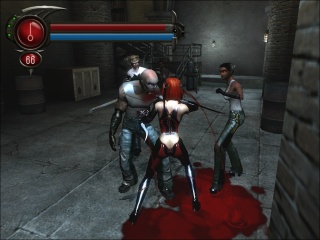
Here's some more Korean indie game coverage, as promised. This time let's once again take a look at a somewhat older game, or rather games, as Team Device has put out a number of them between 2000-2007.


Their first two games, Hana-bi and Reminiscence, are virtual novels. There's hardly anything to be found out about Hana-bi, but there's a (very) short demo for Reminiscence, showing some decent artwork and a story I couldn't care less for. Anyway, to the next game...

To save the best one for last, here's Dangerous China!! Released in 2007, this is their most recent game, a homage to Touhou Project and other than their other, commercial games, free for download. You're basically just dodging knifes thrown by the other girl, but there was an online ranking system, which made the thing a bit more interesting (but has been shut down by now, unfortunately).
Definitely the high point of their catalogue to the average Western gamer is Angel Destroyer, a sidescrolling Danmaku. Somehow I like sidescrolling shmups more than vertical ones, but most I ever see nowadays is vertical, so finding this was a welcome change for me. In the standard setting it feels a bit too easy at first, but already the second stage demands some serious skills. There's a whole bunch of more challenging options, but no easier ones (except setting the number of credits higher), so people who suck at this type of game (like me) are mostly out of luck.

At the beginning of each game one choses between three weapon systems, which greatly affect the difficulty as well. I couldn't tell you much of substance about the scoring system, but every time you dodge a bullet just by a pixel's margin, a "scratch" counter goes up, which seems to affect scoring significantly.

Angel Destroyer also features some great art and story scenes in form of dialogue boxes during the stages.

The game is no longer sold, unfortunately, but everyone can try the demo (as well as most of the other games) through Team Device's homepage, http://teamdevice.net/. The full game has been leaked to certain western sharing communities, although this version is the Japanese one, which lead many to believe that the game is from Japan. Due to the very Japanized art direction in Team Device's games, one really couldn't tell the difference, though.

More recently, the team has worked on another Visual Novel title called Lost Number, but it has put on hold just about two months ago because the artist left the project.















































